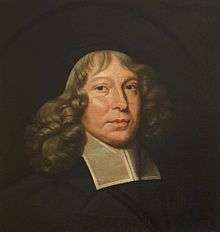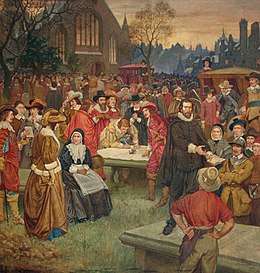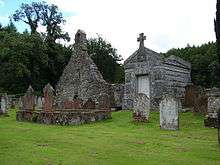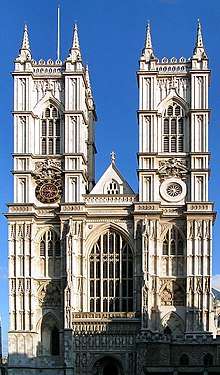Samuel Rutherford
Rev Prof Samuel Rutherford (Rutherfurd or Rutherfoord c. 1600 – 29 March 1661) was a Scottish Presbyterian pastor, theologian and author, and one of the Scottish Commissioners to the Westminster Assembly.
Samuel Rutherford | |
|---|---|
 Samuel Rutherford | |
| Born | c. 1600 Nisbet, Roxburghshire, Scotland |
| Died | 29 March 1661 |
| Alma mater | University of Edinburgh |

.jpg)
.jpg)
.jpg)

.jpg)

Life
Samuel Rutherford was born in the parish of Nisbet (now part of Crailing)[4], Roxburghshire, in the Scottish Borders area of Scotland, about 1600. Nothing certain is known as to his parentage, but he belonged to the Hunthill family (from whom Sir Walter Scott was descended)[5] and his father is believed to have been a farmer or miller. A brother was school-master of Kirkcudbright, and Reader there, and another brother was an officer in the Dutch service.
Rutherford was educated at Jedburgh Grammar School and the University of Edinburgh. After graduating with an M.A. in 1621, he was appointed regent of Humanity at Edinburgh in 1623.[6] He demitted that office in 1626, because of immoral conduct with Euphame Hamilton, who afterwards became his wife.[7] He was admitted to Anwoth Kirkcudbrightshire, Galloway in 1627, probably without Episcopal sanction. It was said of him there that "he was always praying, always preaching, always visiting the sick, always catechising, always writing and studying".[8][4] His patron in Galloway was John Gordon, 1st Viscount of Kenmure.
In 1630 he was summoned before the Court of High Commission, but the charge of non-conformity was not persisted in. Mainly for his publication of a work against Arminianism he was again accused in 1636 by Bishop Sydserff, and after proceedings at Wigtown, was cited before the Commission and prohibited, 27 July, from exercising ministerial office, and ordered to reside in Aberdeen during the King's pleasure. During this period he wrote most of his well-known Letters. His writing desk there was said to be, "perhaps the most effective and widely resounding pulpit then in old Christendom."[9]
In February 1638 Rutherford returned to Anwoth and attended the Glasgow Assembly that year as one of two commissioners from his Presbytery. Shortly afterwards he was elected one of the ministers of Edinburgh, but the Commission of Assembly appointed him, in preference, Professor of Divinity at St Andrews, which office he only accepted on condition that he should be allowed to act as colleague with Robert Blair, one of the ministers of St Andrews, 7 January 1639. He was a member of succeeding Assemblies and consistently supported the Covenanting Party therein. In 1643 he was appointed one of the four main Commissioners of the Church of Scotland to the Westminster Assembly and preached several times before Parliament, remaining in London for four years.[6]
Rutherford was appointed to Principalship at the university in 1647. He was offered in 1648 a Divinity Professorship at Harderwyck in Holland, in 1649 the Chair at Edinburgh, and in 1651 he was twice elected to a Professorship at Utrecht, but all these he declined. In 1643, 1644, 1650, and 1651 he was elected rector of the University, and in 1650 on Charles II.'s visit to St Andrews, he made a Latin speech to him on the duty of Kings. Rutherford was a staunch Protester during the controversy in the Scottish Presbyterian church between the Resolutioners and Protesters in the 1650s.
After the Restoration he was one of the first marked out for persecution: his work Lex Rex was ordered by the Committee of Estates to be burnt at the Crosses of Edinburgh and St Andrews by the hand of the common hangman, while the "Drunken Parliament" deprived him of all his offices[6] and voted that he not be permitted to die in the college.[10]. He was cited to appear before Parliament on a charge of treason, but he died 29th March 1661 [the date — 20th — on his tombstone is an error]. He is buried in the churchyard of St Andrews Cathedral just west of the bell tower. The epitaph on his tombstone includes 'Acquainted with Emmanuel's Love'.[11]
Legacy
One of the classical figures of the Church of Scotland, Rutherford's influence during his lifetime, as scholar, preacher, and writer, was profound and wide, and after his death his name received a popular canonisation which it retains to this day. Some forty editions of his Letters have been reprinted (Bonar's edition contains 365), and innumerable anecdotes of his sayings and doings are enshrined in, and constitute no inconsiderable part of the Scottish tradition. Among his last words were: "Glory shines in Immanuel's Land," on which Mrs Anne Boss Cousin founded her hymn, "The Sands of Time are sinking."
There is also a monument to Rutherford, an Category B listed granite obelisk erected in 1842 on the hilltop overlooking his former parish at Anwoth, in the village of Gatehouse of Fleet, southwest Scotland.[12]
Family
He married firstly in 1626, Euphame Hamilton, who died June 1630, and had issue — Marie, baptised 14 April 1628. He later married again on 24 March 1640, Jean M'Math, who was buried in Greyfriars Churchyard 15 May 1675, and had issue — Agnes (married William Chiesley, W.S.), died 29 July 1694, and six others who predeceased him. He is known to have been friendly with James Guthrie.[13]
Writings
Charles Haddon Spurgeon described Rutherford's letters to be the nearest thing to inspiration which can be found in all the writings of mere men,[14][15] continuing in an 1891 review of Rutherford's posthumously published Letters (1664) 'when we are dead and gone let the world know that Spurgeon held Rutherford’s Letters to be the nearest thing to inspiration which can be found in all the writings of mere men'. Andrew Thomson, a Scottish minister, in a 19th-century biography observed "the letters flash upon the reader with original thoughts and abound in lofty feeling clothed in the radiant garb of imagination in which there is everything of poetry but the form."[16] He continues describing: "individual sentences that supplied the germ-thought of some of the most beautiful spiritual in modern poetry".[16] Elsewhere he talks of "a bundle of myrrh whose ointment and perfume would revive and gladden the hearts of many generations".[9] He also quotes that "each letter, full of hope and yet of heartbreak, full of tender pathos of the here and the hereafter.'[17] Rutherford was also known for other spiritual and devotional works, such as Christ Dying and drawing Sinners to Himself, "The Trial and Triumph of Faith".
Rutherford's political book Lex, Rex, or The Law and the Prince (1644)[18] was written in response to John Maxwell's Sacro-Sanctum Regus Majestas and presented a theory of limited government and constitutionalism.[19] It raised Rutherford to eminence as a philosophical thinker.[20] After the Restoration, the authorities burned Lex, Rex and cited Rutherford for high treason, but his death intervened before the charge could be tried. Rutherford was vehemently opposed to liberty of conscience and his A Free Disputation against Pretended Liberty of Conscience raised the ire of John Milton, who named Rutherford in his sonnet on the forcers of conscience in the Long Parliament. Rutherford also was a strong supporter of the divine right of Presbyterianism (the idea that the Presbyterian form of church government is mandated in the Bible). Rutherford was involved in written controversies over church government with the New England Independents (or Congregationalists). His A Peaceable Plea for Paul's Presbytery in Scotland (1642) was followed by his Due Right of Presbyteries (1644), Divine Right of Church Government and Excommunication (1648) and A Survey of "A Survey of that Sum of Church Discipline" penned by Thomas Hooker (1655), with not only Hooker but also John Cotton and Richard Mather writing books against Rutherford's view of church government.
List of works
- Exercitationes pro Divina Gratia Amsterdam 1636
- A Peaceable and Temperate Plea for Paul's Presbytery in Scotland London 1642
- A Sermon before the House of Commons, on Daniel, London 1644
- A Sermon before the House of Lords on Luke 7:22 London 1644
- The Due Right of Presbyteries London 1644
- Lex Rex, or The Law and the Prince London 1644
- The Trial and Triumph of Faith London 1645
- The Divine Right Of Church Government and Excommunication London 1646
- Christ Dying and Drawing Sinners to Himself London 1647
- A Survey of the Spiritual Antichrist London 1648
- A Free Disputation against Pretended Liberty of Conscience London 1649
- The Last and Heavenly Speech and Glorious Departure of John, Viscount Kenmure Edinburgh 1649
- Disputatio Scholastica de Divina Providentia Edinburgh 1649
- The Covenant of Life Opened Edinburgh 1655
- A Survey of 'The Survey of that Sum of Church Discipline' penned by Mr. Thomas Hooker London 1658
- Influences of the Life of Grace London 1659
- Joshua Redivivus, or Mr Rutherford's Letters 1664
- Examen Arminianismi Utrecht 1668
- A Testimony left by Mr. S. Rutherford to the Work of Reformation uncertain date
- A Treatise on Prayer 1713
- The Cruel Watchman, The Door of Salvation Opened Edinburgh 1735
- Twelve Communion Sermons Glasgow 1876
- Quaint Sermons Hodder & Stoughton, London 1885
- Rutherford’s Catechism: Containing the Sum of Christian Religion. London, 1886
- A discussing of some arguments against Cannons and ceremonies in God’s worship in David G. Mullan (ed.) Religious Controversy in Scotland 1625–1639. (Edinburgh: Scottish Historical Society, 1998), pp. 82–99
Initially sourced from Andrew Bonar's Letters of Samuel Rutherford,[8] with updates and corrections.
Bibliography
Hew Scott's:
- Gilmour's Samuel Rutherford (portrait), Edinburgh, 1904 ;
- Cat. Edin. Univ. Lib., iii. 426 ;
- Whyte's Samuel Rutherford and some of his Correspondents (Edinburgh, 1894);
- Murray's Life (Edinburgh, 1828) and Literary History of Galloway, 76-95 (Edinburgh, 1832);
- St Giles' Lectures, 3rd ser., 73-108 (Edinburgh, 1883;
- Life, by Andrew Thomson, D.D. (Edinburgh, 1884);
- Andrew A. Bonars edition of the Letters (Edinburgh, 1891);
- Philip's The Devotional Literature of Scotland, 116-25 (London, 1925);
- Dict. Nat. Biog. ;
- St Andrews Tests.
See also
- Covenanters
- Andrew Bonar who edited Rutherford's Letters for publication in 1863
- George Gillespie
- Alexander Henderson
- Robert Baillie
- Rutherford Institute, a conservative civil-liberties organization named for Rutherford
References
- Citations
- Fleming 1904.
- Thomson & Hutchison 1903, p. 408-419.
- Thomson & Hutchison 1903.
- Wodrow & Leishman 1842, p. 88.
- Scott 1928, p. 418.
- Scott 1928, p. 419.
- Minutes of Edinburgh Town Council, 3 February 1626
- Rutherford & Bonar 1904, p. 5.
- Thomson 1884, p. 46.
- Barnett 1915, p. 194.
- Rutherford & Bonar 1904, p. 22.
- Historic Environment Scotland & LB3295.
- Wodrow & Leishman 1842, p. 90.
- Spurgeon 1891.
- Whyte 1894, p. 246 (advert on last page).
- Thomson 1884, p. 135.
- Thomson 1884, p. 20.
- Rutherford 1843.
- Campbell 1941, p. 204-288.
- Thomson 1884, p. 136.
- Other sources
- Anderson, William (1877). "Rutherford, Samuel". The Scottish nation: or, The surnames, families, literature, honours, and biographical history of the people of Scotland. 3. A. Fullarton & co. p. 393-395.CS1 maint: ref=harv (link)

- Baillie, Robert; Laing, David (1841–1842a). The letters and journals of Robert Baillie ... M.DC.XXXVII.-M.DC.LXII. 1. Edinburgh: R. Ogle. Retrieved 19 July 2019.CS1 maint: ref=harv (link) CS1 maint: date format (link)
- Baillie, Robert; Laing, David (1841–1842b). The letters and journals of Robert Baillie ... M.DC.XXXVII.-M.DC.LXII. 2. Edinburgh: R. Ogle. Retrieved 19 July 2019.CS1 maint: ref=harv (link) CS1 maint: date format (link)
- Baillie, Robert; Laing, David (1841–1842c). The letters and journals of Robert Baillie ... M.DC.XXXVII.-M.DC.LXII. 3. Edinburgh: R. Ogle. Retrieved 19 July 2019.CS1 maint: ref=harv (link) CS1 maint: date format (link)
- Blair, Robert (1754). Memoirs of the life of Mr. Robert Blair. Edinburgh: Printed by David Paterson. Retrieved 19 July 2019.CS1 maint: ref=harv (link)
- Blair, Robert; M'Crie, Thomas (1848). The life of Mr. Robert Blair, minister of St. Andrews, containing his autobiography, from 1593-1636 : with supplement of his life and continuation of the history of the times, to 1680. Edinburgh: Wodrow Society. Retrieved 19 July 2019.CS1 maint: ref=harv (link)
- Brodie, Alexander; Laing, David (1863). The diary of Alexander Brodie of Brodie, MDCLII-MDCLXXX. and of his son, James Brodie of Brodie, MDCLXXX-MDCLXXXV. consisting of extracts from the existing manuscripts, and a republication of the volume printed at Edinburgh in the year 1740. Aberdeen: Printed for the Spalding club. Retrieved 18 July 2019.CS1 maint: ref=harv (link)
- Barnett, T. Ratcliffe (1915). The makers of the kirk. London, Edinburgh, Boston: T. N. Foulis. pp. 189-194. Retrieved 31 July 2019.CS1 maint: ref=harv (link)
- Campbell, William M. (1941). "Lex Rex and its author". Scottish Church History Society: 204–288. Retrieved 25 August 2018.CS1 maint: ref=harv (link)
- Chambers, Robert; Thomson, Thomas (1857). A biographical dictionary of eminent Scotsmen. New ed., rev. under the care of the publishers. With a supplementary volume, continuing the biographies to the present time. 4. Glasgow: Blackie. p. 216-222. Retrieved 20 April 2019.CS1 maint: ref=harv (link)
- Chisholm, Hugh, ed. (1911). "Rutherfurd, Samuel". Encyclopædia Britannica (11th ed.). Cambridge University Press.
- Christie, James (1909). The records of the commissions of the general assembly of the Church of Scotland holden in Edinburgh in the years 1650-1652. 3. Edinburgh: Printed at the University Press by T. and A. Constable for the Scottish History Society. pp. 159-166. Retrieved 22 July 2019.CS1 maint: ref=harv (link)
- Cousin, John William (1910), "Rutherford, Samuel", A Short Biographical Dictionary of English Literature, London: J. M. Dent & Sons – via Wikisource

- Douglas, J. D. (1964). Light in the north : the story of the Scottish Covenanters (PDF). W. B. Eerdmans Pub. Co. Retrieved 22 April 2019.CS1 maint: ref=harv (link)
- Fleming, David Hay (1904). The story of the Scottish covenants in outline. Edinburgh: Oliphant, Anderson & Ferrier. p. xii. Retrieved 17 July 2019.CS1 maint: ref=harv (link)

- Gilmour, Robert (1904). Samuel Rutherford : a study, biographical and somewhat critical, in the history of the Scottish Covenant. Edinburgh: Oliphant, Anderson & Ferrier. Retrieved 25 July 2019.CS1 maint: ref=harv (link)
- Hewison, James King (1913a). The Covenanters. 1 (Revised and Corrected ed.). Glasgow: John Smith and son. Retrieved 22 July 2019.CS1 maint: ref=harv (link)
- Hewison, James King (1913b). The Covenanters. 2. Glasgow: John Smith and son. Retrieved 22 July 2019.CS1 maint: ref=harv (link)
- Historic Environment Scotland, "Rutherford's Monument (Category B) (LB3295)", retrieved 2 April 2019
- Howie, John; Carslaw, W. H. (1870). "Samuel Rutherford". The Scots worthies. Edinburgh: Oliphant, Anderson, & Ferrier. pp. 232-242.CS1 maint: ref=harv (link)

- Innes, A. Taylor (1883). "Samuel Rutherfurd". The Evangelical succession : a course of lectures delivered in St. George's Free Church. Edinburgh: Macniven & Wallace. pp. 125-172. Retrieved 1 June 2019.CS1 maint: ref=harv (link)
- Johnston, Archibald, Lord Warriston; Paul, George Morison (1896). Fragment of the Diary of Sir Archibald Johnston, Lord Wariston. (May 21-June 25 1639), The preservation of the honours of Scotland, 1651-52, Lord Mar's Legacies, 1722-27, Letters concerning Highland affairs in the 18th century. 26. Edinburgh: Printed at the University Press by T. and A. Constable for the Scottish History Society. Retrieved 17 July 2019.CS1 maint: ref=harv (link)
- Johnston, Archibald, Lord Warriston; Paul, George Morison (1911). Diary of Sir Archibald Johnston of Wariston (Volume 1: 1632-1639). 1. 61. Edinburgh: Printed at the University Press by T. and A. Constable for the Scottish History Society. Retrieved 17 July 2019.CS1 maint: ref=harv (link)
- Johnston, Archibald, Lord Warriston; Fleming, David Hay (1919). Diary of Sir Archibald Johnston of Wariston (Volume 2: 1650-1654). 2. 18. Edinburgh: Printed at the University Press by T. and A. Constable for the Scottish History Society. Retrieved 17 July 2019.CS1 maint: ref=harv (link)

- Johnston, Archibald, Lord Warriston; Ogilvie, James D. (1940). Diary of Sir Archibald Johnston of Wariston (Volume 3: 1655-1660). 3. 34. Edinburgh: Printed at the University Press by T. and A. Constable for the Scottish History Society. Retrieved 17 July 2019.CS1 maint: ref=harv (link)
- Rutherford, Samuel; Bonar, Andrew A. (1904). Letters of Samuel Rutherford. Edinburgh: Oliphants Ltd. Retrieved 25 July 2019.CS1 maint: ref=harv (link)
- Rutherford, Samuel (1843). Lex, rex, or, The law and the prince : a dispute for the just prerogative of king and people. Edinburgh: Robert Ogle and Oliver & Boyd. Retrieved 25 July 2019.CS1 maint: ref=harv (link)
- Scott, Hew (1928). Fasti ecclesiae scoticanae; the succession of ministers in the Church of Scotland from the reformation. 7. Edinburgh: Oliver and Boyd. pp. 418-420. Retrieved 8 July 2019.CS1 maint: ref=harv (link)

- Smellie, Alexander (1903). "A Deathbed in St Andrews". Men of the Covenant : the story of the Scottish church in the years of the Persecution (2 ed.). New York: Fleming H. Revell Co. pp. 49-58. Retrieved 11 July 2019.CS1 maint: ref=harv (link)
- Sprott, George Washington (1885–1900). "Rutherford, Samuel". Dictionary of National Biography. London: Smith, Elder & Co.CS1 maint: ref=harv (link)

- Spurgeon, Charles Haddon (1891). The Sword and the Trowel. ISBN 0-85151388-3.CS1 maint: ref=harv (link).
- Thomson, Andrew (1884). The Life of Samuel Rutherford. London: Hodder & Stoughton. Retrieved 8 July 2019.CS1 maint: ref=harv (link).
- Thomson, J. H.; Hutchison, Matthew (1903). The martyr graves of Scotland. Edinburgh: Oliphant, Anderson & Ferrier. pp. 207-208. Retrieved 30 July 2019.CS1 maint: ref=harv (link)
- Walker, James (1888). The theology and theologians of Scotland : chiefly of the seventeenth and eighteenth centuries (2nd ed.). Edinburgh: T. & T. Clark. Retrieved 22 April 2017.CS1 maint: ref=harv (link)
- Whyte, Alexander (1894). Samuel Rutherford and some of his correspondents; lectures delivered in St. George's Free Church Edinburgh. Edinburgh: Oliphant, Anderson and Ferrier. Retrieved 25 July 2019.CS1 maint: ref=harv (link)
- Whyte, Alexander (1913). "Samuel Rutherford". Thirteen appreciations. Edinburgh: Oliphant, Anderson, and Ferrier. pp. 113-127. Retrieved 25 July 2019.CS1 maint: ref=harv (link)
- Wodrow, Robert; Leishman, Matthew (1842). Analecta: or, Materials for a history of remarkable providences; mostly relating to Scotch ministers and Christians. 3. Glasgow: Maitland Club. pp. 88-90. Retrieved 8 July 2019.CS1 maint: ref=harv (link)
Further reading
- Coffey, John (2004). "Rutherford, Samuel (c. 1600–1661)". Dictionary of National Biography (online ed.). UK: Oxford. doi:10.1093/ref:odnb/24364. Retrieved 10 November 2013.
- Coffey, John, Politics, Religion and the British Revolutions: The Mind of Samuel Rutherford, (1997), ISBN 0-521-58172-9
External links and electronic versions
| Wikiquote has quotations related to: Samuel Rutherford |
| Wikisource has original text related to this article: |
| Wikimedia Commons has media related to Samuel Rutherford. |
- A short biography and selected writings
- Works by Samuel Rutherford at Project Gutenberg
- Works by or about Samuel Rutherford at Internet Archive
- Rutherford, Samuel, Lex, Rex, or The Law and the Prince, London: Constitution.
- ———, A Free Disputation Against Pretended Liberty of Conscience, Third Mill.
- Rutherford, Samuel, Selected writings, Puritan sermons
- Samuel Rutherford by Alexander Whyte at Project Gutenberg
- Rutherford, Samuel (1891). Bonar, Andrew (ed.). Letters (PDF). London: Religious Tract Society.CS1 maint: ref=harv (link).
- Rutherford, Samuel (16 March 2016) [2002/8/4; John Field, Baynards-Castle, 7 Oct. 1644]. Roland, Jon (ed.). Lex, Rex [The Law & the Prince]. Constitution Society.CS1 maint: ref=harv (link).
- Christ Above All, a collection of works by and about Rutherford and other Second Reformation leaders
- Letters of Samuel Rutherford (Joshua Redivivus), in its entirety (free PDF download)
- Lex, Rex, in its entirety (free PDF download)
- The Last and Heavenly Speeches, and Glorious Departure of John Viscount Kenmure (generally attributed to Rutherford), in its entirety (free PDF download)
- Exercitationes Apologeticæ pro Divina Gratia (Apologetic Exercises for Divine Grace), in its entirety (free PDF download)
- Example of Rutherford's literary phraseology in verse form
- . Dictionary of National Biography. London: Smith, Elder & Co. 1885–1900.

